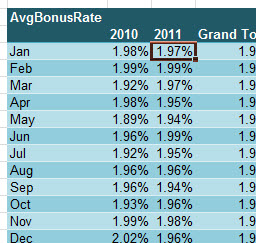Replace Calculated Fields with DAX
March 24, 2023 - by Bill Jelen

The DAX formula language really shines when you use it to create a new measure for your pivot table. DAX measures are in the same genre as calculated fields, but are infinitely more powerful.
To create a new measure, right-click the table name in the Pivot Table Fields pane and choose Add Measure.

Build the measure in the Measure Settings dialog. Use the Check Formula button to check the syntax.
![In the Measure Settings dialog, the Measure Name is Avg Bonus Rate. The formula is =sum(Sales[Bonus]/sum(Sales[Revenue])](/img/content/2023/03/21Fig20.jpg)
Excel will calculate the measure once for every value cell in the pivot table. In the figure below, this means that the calculation will happen 39 times. This is faster than adding the calculation to a million rows of source data.

A complete DAX reference can be found online, and I won’t attempt to replicate that guide here. However, the following topics are the a-ha moments in my power pivot learning curve.
This article is an excerpt from Power Excel With MrExcel
Title photo by Greg Rosenke on Unsplash
